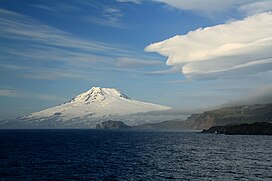| Beerenberg | |
|---|---|
 Beerenberg, July 2011 Beerenberg, July 2011 | |
| Highest point | |
| Elevation | 2,277 m (7,470 ft) |
| Prominence | 2,277 m (7,470 ft) |
| Listing | Ultra |
| Coordinates | 71°4′36″N 8°9′52″W / 71.07667°N 8.16444°W / 71.07667; -8.16444 |
| Naming | |
| Language of name | Dutch |
| Geography | |
 | |
| Geology | |
| Mountain type | Stratovolcano |
| Last eruption | January 1985 |
| Climbing | |
| First ascent | 1921 Wordie, Mercanton and Lethbridge |
Beerenberg is a stratovolcano dominating the northeastern end of the Norwegian island of Jan Mayen. It is 2,277 m (7,470 ft) high and is the world's northernmost subaerial active volcano and the only active volcano in Norway. The volcano is topped by a mostly ice-filled crater about one kilometre (5⁄8 mile) wide, with numerous peaks along its rim including the highest summit, Haakon VII Toppen, on its western side.
Name
Its name is Dutch for "Bear Mountain", and comes from the polar bears seen there by Dutch whalers in the early 17th century.
Description
The upper slopes of the volcano are largely ice-covered, with several major glaciers including five which reach the sea. The longest of the glaciers is the Weyprecht Glacier, which flows from the summit crater via a breach through the northwestern portion of the crater rim, and extends about 6 km (4 mi) down to the sea.
Beerenberg is composed primarily of basaltic lava flows with minor amounts of tephra. Numerous cinder cones have been formed along slope fissures.
History
There was an Austrian attempt to reach the summit of Beerenberg, presumably whilst the Austrians had a weather station on the island in 1882–83, but the attempt failed due to poor weather. The first recorded ascent was in the summer of 1921, by an expedition led by Dr. Paul Louis Mercanton, joined by James Wordie, T.C. Lethbridge and three others. The British expedition was taken to the island by the Norwegian meteorological service, which was establishing a wireless station on the island.
Its most recent eruptions took place in 1970 and 1985, both of which were flank eruptions from fissures on the northeast side of the mountain. Other eruptions with historical records occurred in 1732, 1818, and 1851.
See also
References
- Chetwode, Philip; et al. (1939). "The Imperial College Expedition to Jan Mayen Island: Discussion". The Geographical Journal. 94 (2): 131–134. Bibcode:1939GeogJ..94..131C. doi:10.2307/1787248. JSTOR 1787248.
- "Jan Mayen: volcano in the freezer". Volcanocafe.org. 25 Aug 2015. Retrieved 31 May 2016.
- "Jan Mayen Expedition 1997 European Volcanological Society". Retrieved 4 May 2015.
- ^ "Jan Mayen". Global Volcanism Program. Smithsonian Institution.
- James Gordon Hayes, The Conquest of the North Pole: Recent Arctic Exploration, p. 222, Taylor & Francis, 1934
- Jan Mayen Topographic Map
- Mercanton, P.L. (6 June 1925). "Ascent of Beerenberg, Jan Mayen". Nature. 115 (891): 891. Bibcode:1925Natur.115Q.891.. doi:10.1038/115891a0. S2CID 4129089. Retrieved 31 March 2022.
- Sylvester, Arthur Gibbs. "Seismic Search for Magma Chambers Beneath Jan Mayen and Field Inspection of the 1970 Beerenberg Eruption Area". University of California. Retrieved 31 May 2016.
External links
- New Jan Mayen Homepage, including general info, photos, blog, and webcam
- Old Jan Mayen Homepage Archived 2011-07-22 at the Wayback Machine, including general info, photos, blog, and webcam
- Beerenberg Expedition 2008 Pictures
- Pictures and a map of Beerenberg
- 1970 Beerenberg volcanic eruption captured on film
| Ultra-prominent peaks of Europe | |
|---|---|
| Scandinavia & Arctic | |
| Western Europe |
|
| Atlantic islands |
|
| Alps (List) |
|
| Apennines | |
| Eastern Europe |
|
| Balkans | |
| Mediterranean islands | |
| Caucasus | |
| Jan Mayen | |||||||||
|---|---|---|---|---|---|---|---|---|---|
| General | |||||||||
| Geography |
| ||||||||
| Infrastructure | |||||||||